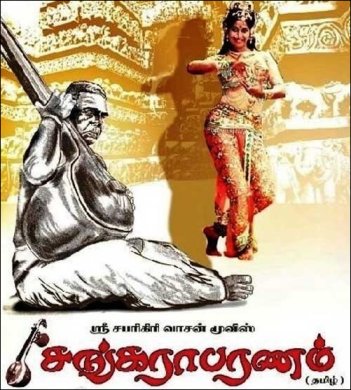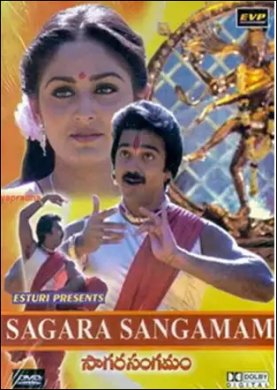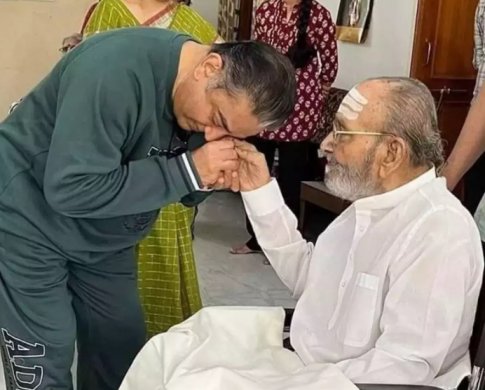
|
 |

|
 |
Movers and Shakers: K. Vishwanath movies - Ranee Kumar e-mail: Ranee@journalist.com February 20, 2023 Movies have held their sway over us in all spheres of life: they have dictated fashion, set behavioural patterns, introduced novel lingo; in short, they have influenced public thinking time to time. If the 40s and 50s spoke of pre and post-Independence, the 60s charmed with their romance and mythology, the 70s, 80s and 90s introduced new concepts with each passing decade while the millennium saw technological innovations and experimentation. In a way, we moved from the natural to the totally celluloid in a matter of four decades. And without resistance! Movie magic being such, we just lap up whatever is on offer. In South of India, Telugu cinema production is the most lucrative commercial venture. Moviemaking involves grand tapestry from exotic locales to expensive settings and nothing short of crores has always been the investment initiative as way back as the 80s. Bling was the word. Except for mythological movies which always had an assured audience, the crime thrillers or social stories were downright fancy, bordering on unrealistic plots and action. It was a mixed masala of villain, an incredulous hero, a dumb doll of a heroine, a vamp gyrating in a club or gathering, stunts at the drop of a hat and what more a happy ending. Exceptions in this beaten track were far and few. The social status of the then united Andhra Pradesh, one of the richest states in the country, was US beckons. Every second girl and boy was studying engineering or medicine with sights set at going to USA to make more money. The lesser privileged were also driven by technology lure and were into learning computer skills to get into small but lucrative jobs. Coastal Andhra, once ruled by Rajaraja Narendra of the eastern Chalukya dynasty and also under the Cholas for some time, was the seat of classical literature, music and dance which thrived till as late as the '70s. Then, came a sudden change in attitude to performing arts as something not viable and at best be side-lined into a hobby for the upper crust in social status. Beyond this, dance and music were exclusive property of the dancing community girls and women of such taboo regions like Peddapuram and other minor places that dotted the rich belt of coastal Andhra. Academics took priority and professional colleges both government and private, were citadels of lucrative future for girls and boys of the times. It was in such a milieu that ace film director K Vishwanath used his directorial ventures as tools of social transformation. A classicist to the core and a keen observer of the society, he pioneered a cinema with a purpose: to inculcate the lost values of traditional arts, shun caste-based discrimination and influence youth to follow their heart and heritage. His target audiences were the literate middle classes and educated upper classes which form a major chunk of any given society. He had a subtle way of ushering in change which made for the success of his movies. A handful of films that brought in a sea change in the thought process of the Telugu mind and finally led to a total change in outlook and life choices were the famed Sankarabharanam, Saptapadi, Sagara Sangamam, Siri Vennela, Sruti-Layalu, Swarna Kamalam and Swarabhishekam.  Manju Bhargavi in Sankarabharanam Sankarabharanam was something of a runaway hit. It was like a fresh lease of life to the parched cinema goers of the '80s whose staple diet was crass melodrama or glossy mythologicals with a crime thriller thrown in now and then. K. Vishwanath's movies were a class apart - a finesse that surpassed excellence, aesthetic appeal, a message that was sweetly suggestive and thought-provoking. Sankarabharanam served as a pointer to the westerly winds blowing our way, sweeping us off our feet to the extent of obliterating our traditional knowledge that the gamaka-ridden (oscillating) Carnatic raga Sankarabharanam is a challenging version of the rather plain C-Major scale. This distinction was vividly brought out in a powerful scene within the story. Such other instances ignited the young audiences and more so, the parents whose senses started to savour the innate strength of our music. A spurt of interest to go back to classical music which once was a household routine, led to few families joining music classes in institutes or engaging private tutors for home coaching. Close on the heels of Sankarabharanam came Saptapadi (Jaag Utha Insan), a dance-based movie that kindled the classical dance fire with its fantastic choreography buttressed by stupendous songs set to classical ragas. Everybody who was anybody was bitten by the classical dance bug. There's a reason for this 90 degree tilt towards performing arts. The audience who thronged the theatres to view a Vishwanath film could easily identify with the flesh and blood characters of his cinema. The heroine and hero of his stories were like the girl and boy next door; they underwent similar experiences and feelings like any one of us; their ambitions and life were more or less like ours; the families which were portrayed were ordinary people with extraordinary values and ideas. These traits were highly appealing to the common audiences. Emulating them seemed the best possible path to excel in one form of art or the other apart from routine academic pursuits. Post-Saptapadi, medical students also began pursuing dance as an alternate passion and found performing platforms amid strenuous studies. Songs like Nagumomu (Abheri) and Marugela ra O Raghava… (Jayantashri) were hummed in every household. From adults in the family to teenagers and youth, everybody wanted to learn these two lilting Thyagaraja kritis. Mind you, this sort of enthusiasm from families who were far removed from the realm of Carnatic music! Vishwanath's movies were layered: story had a familial approach and identity and hence its own appeal; songs were from well-known kritis of Thyagaraja but not heavily formatted, therefore easy to emulate and the dance element was the highlight. In the case of Saptapadi, it was racy Kuchipudi dance directed by Kuchipudi master Seshu. Though the heroine was a newcomer with a girl-next-door looks, her dances to those melodic songs went viral sort of. Suddenly, there was a regional spurt in desire to get young girls and boys to learn Kuchipudi. Though Andhra had number of dance teachers - male and female - never was there an exodus at every teacher's threshold.  Kamal Hasan and Jayaprada in Sagara Sangamam  Kamal Hasan with K Vishwanath Sagara Sangamam further enriched the dance initiative among Telugu households. This movie had a star cast - Kamal Hasan and Jayaprada - a name unto themselves. Again a strong story on the passion for dance, life upheavals leading to break in performances, classical dance getting diluted and misrepresented by an arrogant younger lot - this movie was out and out a dance subject. Obviously, it churned not just interest in learning the art form but striving to gain knowledge of its deep connotations and instilling a sense of respect towards art and gurus. Overnight, dance teachers were placed on a pedestal and were addressed as guru with demonstrative respect by elders and disciples as well. The typical Andhra mentality of looking upon a teacher as someone who inculcated vidya for a fee and hence could be dealt with marginal respect took a beating with Sagara Sangamam. Vishwanath inculcated a sense of devotional respect towards teachers of performing arts as against tuition teachers.  Bhanupriya in Swarna Kamalam Swarna Kamalam again was in the cause of dance, especially Kuchipudi which was the bastion of Brahmin preceptors and performers originally. The social milieu of the Telugu middle-class which looked up to fancy jobs and life in the alluring US of A, was captured in every frame possible from culture to behavioural, ignorance of traditional arts leading to disgust and disregard for these arts as obsolete in the present day fast-changing world - the finest of fine elements were brought out with sensitivity in a story laced with lots of humour and punchy dialogues. Kuchipudi dance scaled popularity charts and with the subtle didacticism of Vishwanath's films like Swarna Kamalam. Dance was viewed with new-found respect and not as a mere entertainment tool. In Siri Vennala and Swarabhisekham the storyline was more powerful than Sagara Sangamam. Both the later movies revolved round life of musicians - a roller coaster prior to getting established in Siri Vennela and in the other, the director dealt with the darker side of music - guru performer that wrecks the disciple costing his life. Music score again was based on classical raga. In fact, a talented but unrecognized lyricist got his great break with Siri Vennala from where there was no looking back for him. In fact, Siri Vennala got prefixed to the name of Sitarama Sastri and we all forgot his surname! Sruti Layalu was one of his finest movies on music with woman empowerment as its bedrock. Child artiste Shanmukha Srinivas, a gifted Kuchipudi dancer was hand-picked for the role. The dance for Narayana Teertha Tarangam in the backdrop of Varanasi temple as also the music score, this time had its lasting influence on the boy brigade. Parents without daughters, flooded to music schools or home tuitions and scouted for dance teachers to get their young sons to learn Kuchipudi and vocal music. Fortunately, Kuchipudi, essentially a male dance, was easily accepted by conservative families in the enthusiastic wave of encouraging their young boys to learn and perform. There was a time, when parents with their artistic wards thronged Vishwanath's household to just have his darshan and be blessed by him. He became a cult figure, but his down to earth attitude never allowed him to sway with the popularity charts.  Actor Chiranjeevi with K Vishwanath Despite new tech-savvy, super high budget movies bombarding the Telugu cinema market relegating the story-oriented films to the back burner, Vishwanath's charisma in the Telugu land never faded with time. His movies turned into a trickle and that left a void that will remain until there is a renaissance of sorts in film production. With TV reality dance and music shows and a completely transformed society and people, it is like hope against hope.  Ranee Kumar is a journalist who brings in three decades of hard core journalistic experience with.mainstream papers like the Indian Express and The Hindu to arts reporting. Her novel 'Song of Silence' and guest editing of attenDance widen her horizon. Post your comments Pl provide your name and email id along with your comment. All appropriate comments posted with name & email id in the blog will also be featured in the site. |